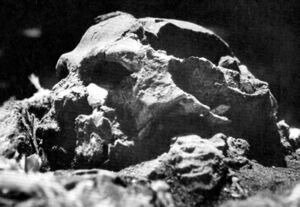We're back! Sorry, bad combo of sickness, funeral and a month-long trip abroad. The site is back now. |
Pangaean Code
This article is a construction site. This project is currently undergoing significant construction and/or revamp. By all means, take a look around, thank you. |
| Pangaean Code | |
|---|---|
| Codex | |
 Photographed skull of Shanidar I | |
| Created by | Veno |
| Date | c. 50,000-12,000 BP |
| Setting | Middle-East (?) |
| Native speakers | - (2024) |
Default
| |
Map of areas where the Codex is believed to have once been spoken | |
Pangaean, also referred to as Primordial, Codes, or Codex, is a philosophical ab interiori language of the Upper Paleolithic that consists on codifying the alphabet of thought into articulated sounds. Its creator, Veno, named it after the hypothesis of Paleolithic Codes, wherein the language would be the oldest one.
The Codex is very similar to Gottfried Wilhelm Leibniz' idealization of a Characteristica Universalis, although the presence of Mnemonics and Sound Symbolism may set it apart from a genuine calculus ratiocinator. Meaningful units are mimetic rather than numeric (called phememes), whose discussion first appeared in Plato's Cratylus before being developed in the 20th Century by anthropologist Mary LeCron Foster. With those phememes [...]
[...]
Other constructed languages similar to the Pangaean Code include Ithkuil (in morphological complexity), Lojban (in syntactic complexity), and IEML (in semantic complexity).
Codes
Grammar
a phone such as [k] contains the following distinctive features ...
... distinctive features are not equal to X attributes...
| production articulation ... position |
[1]
ẞ *turbulence, Ȝ *sonority, 𐌁 *occlusion
[2]
[K] [P] [T] [Y] [N] [L] [H] [0] [S]
[3]
[√k] [√g] [√ƙ] [√ɠ] [√p] [√b] [√ƥ] [√ɓ] [√t] [√d] [√ƭ] [√ɗ] [√ь] [√j] [√ʍ] [√w] [√μ] [√m] [√ᴎ] [√n] [√л] [√l] [√ρ] [√r] [√h] [√ɦ] [√χ] [√ʁ] [√ħ] [√ʕ] [√ʔ] [√ʘ] [√ʇ] [√ʖ] [√s] [√z]
[4]
[k̠] [k] [k̟] [g̠] [g] [g̟] [ƙ̠] [ƙ] [ƙ̟] [ɠ̠] [ɠ] [ɠ̟] [p̠] [p] [p̟] [b̠] [b] [b̟] [ƥ̠] [ƥ] [ƥ̟] [ɓ̠] [ɓ] [ɓ̟] [t̠] [t] [t̟] [d̠] [d] [d̟] [ƭ̠] [ƭ] [ƭ̟] [ɗ̠] [ɗ] [ɗ̟] [ь̠] [ь] [ь̟] [j̠] [j] [j̟] [ʍ̠] [ʍ] [ʍ̟] [w̠] [w] [w̟] [μ̠] [μ] [μ̟] [m̠] [m] [m̟] [ᴎ̠] [ᴎ] [ᴎ̟] [n̠] [n] [n̟] [л̠] [л] [л̟] [l̠] [l] [l̟] [ρ̠] [ρ] [ρ̟] [r̠] [r] [r̟] [h̠] [h] [h̟] [ɦ̠] [ɦ] [ɦ̟] [χ̠] [χ] [χ̟] [ʁ̠] [ʁ] [ʁ̟] [ħ̠] [ħ] [ħ̟] [ʕ̠] [ʕ] [ʕ̟] [ʔ̠] [ʔ] [ʔ̟] [ʘ̠] [ʘ] [ʘ̟] [ʇ̠] [ʇ] [ʇ̟] [ʖ̠] [ʖ] [ʖ̟] [s̠] [s] [s̟] [z̠] [z] [z̟]
Primordial sentences have the following morphological structure:
- (((#3C-#2V2H#1V1#1HV2#2-C#3)C)V)# (((#3C-#2V2H#1V1#1HV2#2-C#3)C)V)#-(((#3C-#2V2H#1V1#1HV2#2-C#3)C)V)#-(((#3C-#2V2H#1V1#1HV2#2-C#3)C)V)# (((#3C-#2V2H#1V1#1HV2#2-C#3)C)V)#
Where [...]
√k as a sound [§ I.I.I.I.□111] or as a morphological actor [§ I.U.I.I.□1131]...
Metaphysics
Pragmatics
Romanization of Pangaean...
p̈̇ëyṛ /pʕɛ̃u̯hr/
p̈̇e̋yṛ /pʕɛ̤̃u̯hr/ *p̈̇ȅyṛ /pʕu̯ɛ̤̃hr/
p̈̇ē̄yṛ /pʕɛ̰̃u̯hr/ *p̈̇ēyṛ /pʕɛ̰̃i̯hr/
p̈̇ē̄yuṛ /pʕɛ̰̃u̯˥hr/ *p̈̇ē̄yiṛ /pʕɛ̰̃u̯˩hr/
u /X˥/ uu /X́˥/ uo /X̂˥/
p̈̇ē̄yuoṛo̹a /pʕɛ̰̃̂u̯˥hora/
p̈̇ëaṛ /pʕɛu̯hr/, ḥuḥ /huh/, ṣuḳ /shuhk/, phy /pʼə/, mhy /m̥ə/, mqy /m̠̊ə/, mxy /m̟ə/,
ḧ̇ = ʕ, ḥ̈̇ = ...
ṗ p̈ p̈̇ p̣ p̤ p̬ | b b̈ b̂ ...
ä̇ ë̇ ï̇ ö̇ ü̇ = /aə̯ eə̯ iə̯ oə̯ uə̯/
ä ë ï ö ü = /au̯ eu̯ iu̯ ou̯ uu̯/
ȧ ė i̇̇ ȯ u̇ = /ai̯ ei̯ ii̯ oi̯ ui̯/
|
... ạ ẹ ị ọ ụ = /i̯a i̯e i̯i i̯o i̯u/
|
iu eu uu ou au yu = /.../
ia ea ua oa aa ya = /e̞ ɛ o̞ ɔ ɐ a̯/
ii ei ui oi ai yi = /.../
|
... ee = /ɪ̃/
... ey = /ɛ̃/
... eo = /ɤ̃/
|
h̤̣yu̜k̤̣hiḥu̹am ḥyh̤ki ur "maybe here during the reign of cats"
Other resources=
Philosophie der Logik
Jakobson, Roman; Fant, Gunnar; Halle, Morris (1952). Preliminaries to Speech Analysis: the Distinctive Features and their Correlates. Cambridge, Massachusetts: MIT Press. ...

